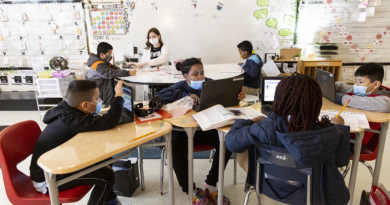3 Habits of Highly Effective Teacher Teams
When time is of the essence—and the goal is to drive deeper student learning—here are three ways to keep teacher teams focused and productive.
As schedules fill up in the new school year, the practice of meeting as teacher teams can be tough to fit into the day.
But there’s tremendous value in establishing a consistent, structured routine of grade- or subject-focused meetings—especially when schools plan and carve out time for it. When teachers meet as teams, writes consultant Elisa B. MacDonald for ASCD, they learn to “cultivate diverse perspectives, ground disagreement in text-based ideas (not personal attacks), promote intentional data use, and focus team meetings on what collaboration is ultimately about—improving student learning.”
There’s no need to make it overly complicated: By keeping the work lean and focused on just a few discrete areas, teachers can benefit in spite of time constraints. “It’s enough to start with small, intentional moves to build a culture of trust gradually,” writes MacDonald, a former teacher and literacy coach. “In time, your team will view reading together, observing one another teach, and looking at student work together not only as practices you do in meetings but as healthy collaborative habits that transform learning.”
Here are three strategies MacDonald recommends for getting the most out of teacher teams:
1. Read and Listen Together
While reading by yourself is beneficial, discussing articles, videos, and podcasts with colleagues provides a rich opportunity for team members to broaden their thinking and deepen their understanding of the content as they hear new ideas and challenge their own perspectives.
If your school doesn’t set time aside for PD or collaborative team reading, start off with “short, engaging texts”—MacDonald suggests a relatable cartoon, a controversial quote, or an inspirational excerpt from a podcast—then build up to longer texts and book studies as the year progresses and teachers’ schedules allow. “Soon, your colleagues will expect to engage in text-based discussions in your meetings,” she says.
In lieu of using text-based discussion protocols, such as the four A’s or the final word, which MacDonald notes can feel “time-consuming or restrictive,” a well-formulated prompt can help structure a thoughtful conversation and encourage quality, relevant responses. When school DEI director Osamagbe Osagie’s team read the article “Growing up Black in All the Wrong Places,” for example, she asked her team: “Given this article’s provocative title, what will it take for us to create a world that is comfortable and safe for individuals who are Black, Indigenous, Latinx, Asian, and multiracial to grow and thrive in?” MacDonald writes.
2. Observe Colleagues in Classrooms
In high-performing schools, teachers often visit colleagues’ classrooms for peer observation, a practice MacDonald compares to the difference between “seeing a movie with friends, catching a bite afterward, and talking about what you saw together” versus seeing the same movie alone.
When team leaders establish clear goals for a classroom visits, it helps keep the process streamlined and prevents team members from being overwhelmed by the variety of ideas they encounter.
- Establish a clear objective for each observation: First visits can be unstructured, but subsequent visits should include clear guidance about what to look out for, and should connect to whatever the team is learning about, MacDonald says.
- Be specific about goals: Though your team may collaboratively write or review an entire lesson plan together, it’s fine to demo just a portion of it for the team to examine together, MacDonald explains.
- Identify how to gather data: “Guided by your purpose, decide what data your team will collect to help your team debrief afterward,” MacDonald writes. You might agree to record audio of student group discussions or take photos of completed student work.
- Mix it up: Plan to observe live and pre-recorded lessons and “dry demos,” where a teacher presents a lesson to colleagues without students in the room. This exercise reduces stress for the presenting teacher—they can start over or stop at any point in the process—while providing an opportunity to practice strategies before bringing them into the classroom.
3. Examine Student Work
If you can’t routinely visit other teachers’ classrooms, regularly evaluating student work as a team is a valuable exercise. On a rotating basis, each member can bring in student work samples that are:
- Authentic: Sample work should reflect a genuine issue or challenge for the presenting teacher(s).
- Relevant: Submitting samples that are relevant to team inquiry and study goals ensures that the team benefits from the analysis.
- Current: Use recent samples—from formative assessments, for instance—so that teachers can “reteach, intervene, or enrich when students need it,” MacDonald advises.
While it may be tempting to “go big or go home” with team meetings, the realities of crammed teacher schedules can interrupt even the best intentions. Starting small—consider picking just one strategy to start—is worth the effort, MacDonald concludes. Strong teacher teams can sustain teachers, helping them connect to colleagues and feel supported—ultimately keeping educators engaged in the work and learning from each other.
Source: https://www.edutopia.org/article/3-habits-highly-effective-teacher-teams




